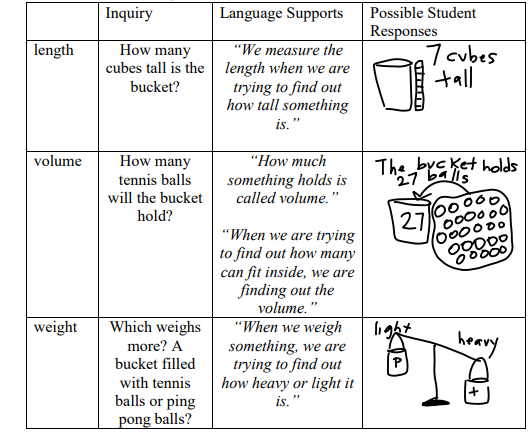General Information
Benchmark Instructional Guide
Connecting Benchmarks/Horizontal Alignment
Terms from the K-12 Glossary
- NA
Vertical Alignment
Previous Benchmarks
Next Benchmarks
Purpose and Instructional Strategies
The purpose of this benchmark is to develop an understanding for measurement and attributes that can be measured, without focusing on the value of the measurement. Through this benchmark students begin to develop related vocabulary they will also apply in later benchmarks and grade levels.- Instruction includes students describing measurable attributes and using vocabulary such as tall, short, long, heavy and light (MTR.4.1).
- Instruction includes the introduction of terms to compare measurable attributes, such as longer, shorter, heavier and lighter.
- Instruction includes concrete objects as well as images and context to describe measurable attributes (MTR.7.1).
- The expectation of this benchmark is not to focus on numerical values of measurement by estimating or measuring, but to develop understanding of attributes that can be measured and vocabulary used to describe those attributes.
Common Misconceptions or Errors
- Students may confuse volume with weight, or length with volume.
- Students may assume that there is only one way to describe attributes.
- For example, one students may conclude that an object is short, heavy or long, while another may conclude the opposite. The students may assume that one of them has to be correct.
Strategies to Support Tiered Instruction
- Instruction includes opportunities to use the same object to explore multiple attributes during different lessons, actively participating in experiences that include inquiries in which length, volume, and weight must be considered. Students are encouraged to verbalize their thinking while a teacher scaffolds with use of math vocabulary during the activity. Teachers guide student discussions and models think-aloud about each attribute by connecting student-centered language with key mathematical vocabulary. Record the results of measurement investigations by drawing, labeling, and verbally communicating to peers or teacher about their results.
- For example, how many ways can we measure a bucket?

Instructional Tasks
Instructional Task 1
Provide students with various objects (or cards with pictures of objects) of different sizes (lengths, heights, and weights). In small groups ask students to sort the objects by different attributes; such as shortest to longest or lightest to heaviest. Facilitate conversations with the group focusing on developing student’s vocabulary and development of corresponding concepts. Compare different ways of sorting the objects (for example, the longest may not be the heaviest, etc.).
Instructional Items
Instructional Item 1
Connect each object to (a) word(s) that could be used to describe it.*The strategies, tasks and items included in the B1G-M are examples and should not be considered comprehensive.
